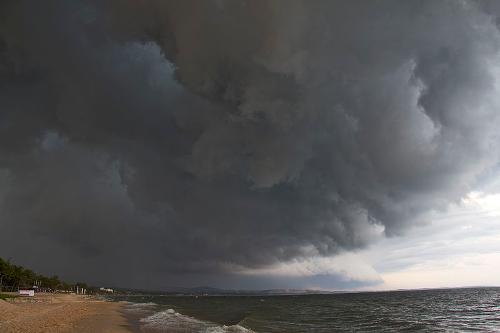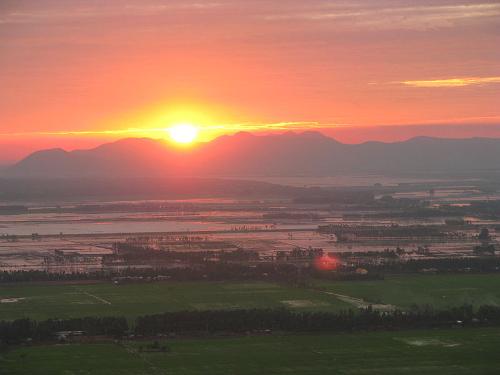VIETNAM
Climate and Weather

Climate and Weather
Cities in VIETNAM
| Hanoi |
Climate and Weather
 Monsoon clouds over VietnamPhoto: Jean-Marie Hullot CC 3.0 Unported no changes made
Monsoon clouds over VietnamPhoto: Jean-Marie Hullot CC 3.0 Unported no changes made
Due to the elongated shape of Vietnam, there are major climatic differences. The south and in particular the Mekong Delta is tropical with average temperatures that are fairly constant around 30 ° C. The north is subtropical and above 2000 meters there is even a moderate climate. Vietnam is further in the monsoon zone of Southeast Asia and the climate border is at Da Nang.
The differences per region are large; when the rainy season arrives in the mountains, it is sunny and dry on the coast. And if it is quite cold in the winter in the northern mountain area, it is nice and warm in the south. In Vietnam there is an average of between 1100 and 2600 millimeters of precipitation. Especially on the coast between Quy Njon and Vinh, more than 2000 millimeters fall annually due to the rapid rise of the landscape.
Vietnam has quite a few thunderstorms, in the north about forty days a year and in the south even about sixty days a year. In the north, the sun shines an average of 1167 hours a year, in Central Vietnam 2,224 hours a year and in the south much less, 1,621 hours a year.
The hurricane season for the sea area near Vietnam runs from May 1 to January 1, and in July, August, September and October there is a good chance of a typhoon struck Vietnam.
In the north, summer starts as early as April with subtropical temperatures and high humidity. Especially in July and August it rains a lot, but also in the rest of the year there are regular showers. Hanoi receives nearly 1,700 millimeters of rain every year. In September, summer will end in the north and temperatures will drop to around 15°C in January.
 Sunset Mekong Delta, VietnamPhoto: McKay Savage CC 2.0 Generic no changes made
Sunset Mekong Delta, VietnamPhoto: McKay Savage CC 2.0 Generic no changes made
In the south, the southwest monsoon prevails and it can get very hot from January to April with temperatures reaching well above 30 °C and reaching 40 °C on a daily basis. In April and May it becomes even more unpleasant due to the very high humidity, which then rises to above 90%. The rainy season starts in May and is characterized by strong short showers. July to September is the time when most rain falls. The Mekong Delta regularly experiences flooding in the summer after heavy rainfall in Laos and Cambodia. Nha Trang is one of the driest places in Vietnam with an annual approx. 1200 millimeters. In the mountains around Da Lat in the south, the temperature sometimes drops to zero in winter.
The weather is generally worst in the northern coastal region of central Vietnam, with heavy rainfall from August to January. This part of the coastal area therefore suffers a lot from devastating hurricanes or taifuns. Dry months are June and July. In the southern coastal region there is a rainy southwest monsoon from October to December. The dry season runs from May to September.
The highlands around Da Lat have an erratic climate with rain all year round. This is caused by foothills of both the southwest and the northeast monsoons. The relatively dry season is between September and March.
At the beginning of November 1999, Vietnam had to deal with heavy rainfall for weeks on end. Floods then claimed the lives of more than 500 people. On November 1, 1999 alone, quantities of up to 500 mm in one day were measured all over the country. In five days, the coastal city of Da Nang in central Vietnam caught more than 900 mm of rain. Normally, less than 400 mm falls here in the entire month of November.
Sources
Krücker, F.-J. / Vietnam
Elmar
Paulzen, H. / Vietnam : mensen, politiek, economie, cultuur, milieu
Koninklijk Instituut voor de Tropen
Peterse, L. / Vietnam
Gottmer/Becht
Te gast in Vietnam
Informatie Verre Reizen
Vietnam
Cambium
Vietnam
Lannoo
Wulf, A. / Vietnam
Het Spectrum
CIA - World Factbook
BBC - Country Profiles
Last updated November 2025Copyright: Team The World of Info